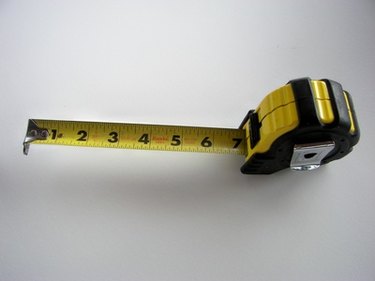
Black pipe is used in the installation of household gas lines. The pipe is made of steel and is coated black to make it easily recognizable. Three-quarter-inch and half-inch diameter gas pipes are usually installed, and the ends of each section of pipe come pre-threaded. Steep couplings and threading compound are used to join sections of pipe together, with new gas pipelines being installed section by section starting at the gas meter and working towards the gas appliance(s). Calculating the length of each section of pipe is a fairly simple step-by-step process.
Step 1
Measure the length of the first section of gas pipe from the inlet on the gas meter, or T/elbow coupling on the existing gas pipeline, to the first bend in the pipe. The bend will be created by installing an angled steel coupling into the line at that point. A rule of thumb is that a gas pipeline should run in a continuous straight line from the meter to the gas appliance, unless an object -- joist, existing pipe -- is in the way. When the gas appliance is on a different level than the gas meter, which is almost always the case, angled couplings will also be used to create the required angle to run the pipe to another level.
Video of the Day
Step 2
Measure from the first coupling to the point in the line where a second obstruction exists and another angled coupling needs to be installed. Note that sections of gas pipe come in various lengths, but not odd lengths such as 5 3/8 inches. Though gas pipe can be cut to any length and threaded at most major DIY stores when an odd length is really needed, it is best to make measurements that correlate to lengths of gas pipe that are readily available in the store. For example, if an obstruction dictates that a piece of pipe be 9 1/4 inches long, install a readily available 10-inch pipe, if room permits, to get around the obstacle.
Step 3
Measure all remaining sections of gas pipe in this fashion until the gas fixture is reached. If possible, lay out all sections of gas pipe, as well as couplings, in a flat space to visually see the run of the new gas line. Then take each section and coupling, one at a time, and install it into place into the new gas line.
Tip
Steel gas couplings come in various angles ranging from 30 to 90 degrees to help run gas lines around obstructions. Straight couplings are also available, as well as T couplings where one gas line connects to another.
When measuring from one coupling to the next, make allowance for the amount that the pipe thread will enter into each coupling, usually 3/4 inch.
Video of the Day